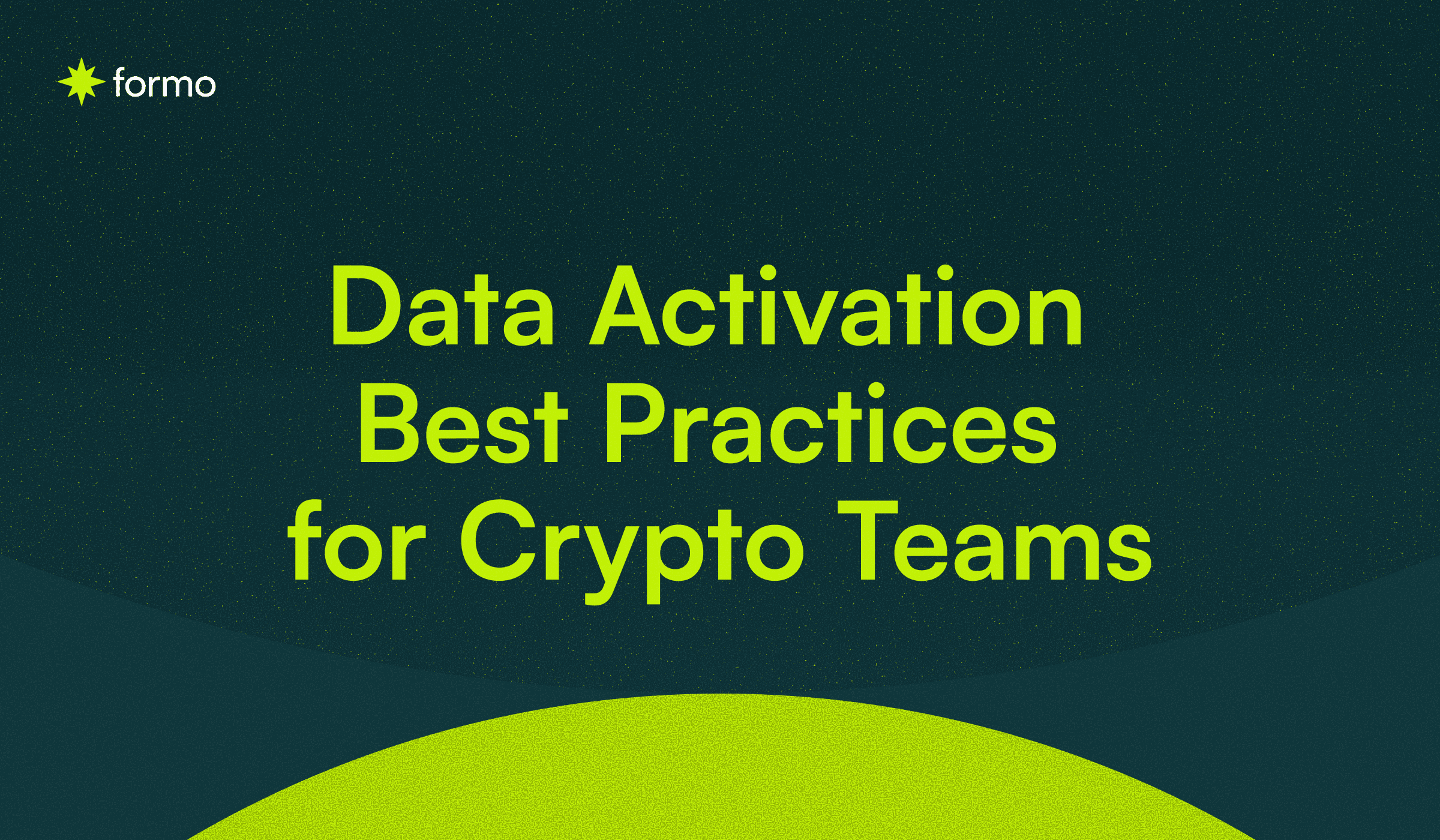As blockchain adoption accelerates, Web3 startups are turning to Web3 Forms as a powerful alternative to traditional tools like Google Forms. These token-gated forms offer a secure, data-rich way to collect both onchain and offchain data, while verifying user access through wallet authentication. In 2024, Web3 Forms have revolutionized how teams capture onchain data and analyze user behavior across decentralized platforms. In this article, we’ll explore 7 impactful use cases for Web3 Forms.
Key Takeaways:
Web3 Forms provide wallet/token verification, onchain analytics, and social account verification.
They outperform Google Forms for Web3-specific needs such as Sybil resistance, token-gated access, and data integrity.
Use cases include: registrations, user research, hiring, allowlists, signups, grant applications, and contact forms.
Formo enables customized, crypto-native forms for community engagement and product growth.
Looking for a Deform alternative? Check out Formo.
Are Web3 Forms better than Google Forms?
Google Forms integrates well with the Google ecosystem but lacks the features Web3 projects need. Think of Google Forms as a basic option for surveys. In contrast, Web3 Forms (token-gated forms) focuses on advanced data collection, offering wallet verification, social media verification (X, Discord, Farcaster, Telegram), and token ownership verification.
Web3 startups are increasingly moving away from traditional tools like Google Forms and embracing Web3 Forms—blockchain-native solutions designed to capture, verify, and analyze user interactions with decentralized precision. Unlike standard forms, Web3 Forms combine wallet verification, token-gating, and onchain/offchain data collection, allowing teams to securely track user behavior and engagement while preserving privacy. These forms are transforming how Web3 projects run event registrations, allowlists, surveys, and grant applications, creating smarter and more meaningful data pipelines.
Traditional form tools rely on emails or cookies, making them vulnerable to spam, fake accounts, and limited cross-platform insights. In contrast, Web3 Forms leverage blockchain technology to:
Authenticate users via wallet addresses
Gate form access based on token or NFT ownership
Connect offchain interactions to onchain activity
Provide auditability and verifiable submission data
This enables Web3 teams to track the full user journey, from initial engagement on websites or social channels (offchain) to real interactions on DeFi and social protocols.

Google Forms interface
Here’s how specific Web3 Forms solve challenges that Google Forms cannot:
Wallet verification: Web3 Forms help teams to ensure that only verified wallets can access forms, protecting against Sybil attacks and enhancing trust.
Token gating: Projects restrict access based on token ownership, ensuring only community members can view exclusive content.
Onchain analytics: Web3 Forms capture both onchain and offchain user data, offering insights that traditional form builders can’t match.
Enhanced customization: Web3 Forms empowers teams to design forms with customizable branding, reflecting the unique identity of each Web3 project.
7 use cases for Web3 Forms
Here are 7 use cases for Web3 Forms to enhance how teams capture data and acquire users:

Leverage access gating with 7 use cases for Web3 Forms
Registration Forms
Web3 Forms make event, course, or membership registrations more secure and easier by verifying participants’ wallets. Attendees can join an event or a webinar with NFT tickets or token-gated access, ensuring a personal experience.

Registration form | Web3 Saigon Community
User research
Product and marketing teams use Web3 Forms to collect valuable and genuine feedback without obtaining personal information from users through wallet and social media verification. They can analyze onchain data to understand user preferences for more informed product and marketing decisions.

Survey form | Dabl Club
Job Application Forms
Web3 Forms simplifies hiring by allowing applicants to submit their resumes and file projects while verifying their social media. This makes it easy for employers to confirm the applicants' skills. Additionally, applicants can submit their portfolios as NFTs or link their Web3 profiles, such as ENS domains.

Application form | Auditless
Waitlists & Allowlists
Web3 Forms manage waitlists or allowlists by verifying user eligibility onchain, ensuring only qualified individuals can join. Token-gated waitlists prevent bots or irrelevant users from joining, keeping the list clear and efficient.

Allowlist form | Scroll
Signup forms
Web3 Forms improve your onboarding with wallet verification and token ownership verification, allowing users to sign up for newsletters, events, or exclusive communities. You can then use responses as valuable data for marketing strategies.

Sign-up form | Boost
Grant Form
Web3 Forms provide a convenient method for collecting grant applications. Web3 brands can utilize token-gated forms to verify applicants' projects, collect portfolios, and ensure they meet onchain criteria, such as holding governance tokens.

Grant form | Magic Square Ecosystem
Contact Forms
Web3 Forms enhances the contact process by adding a layer of verification through wallet authentication. Additionally, it helps teams customize branded forms to improve brand recognition and awareness among users.
Formo’s contact form | Layer3
The Future of Web3 Forms
Formo empowers product and marketing teams by offering a seamless way to create forms and surveys integrated with onchain data. Unlike traditional form builders, Formo combines simple form creation with advanced features for Web3-native projects such as wallet verification, access gating, and customized design.
While Google Forms is a popular choice for general data collection, they do not fully meet the needs of Web3 projects. Web3 Forms offer enhanced functionality, improved privacy, and seamless blockchain integration. Token-gated Forms are ideal for capturing feedback, managing registrations, and hiring in Web3. If your team works with onchain data or within Web3 communities, use Web3 Forms now to adopt and thrive in growth.
Further sources:
Follow us on LinkedIn and Twitter, and join our community to see how Web3 leaders use Formo to drive growth in less time.
FAQs
1. What are Web3 Forms?
Web3 Forms are blockchain-native alternatives to Google Forms that include wallet verification, token-gating, and onchain/offchain data collection. They enable Web3 teams to capture secure, verifiable user interactions while linking offchain engagement to onchain activity.
2. How do Web3 Forms differ from Google Forms?
Unlike Google Forms, Web3 Forms:
Authenticate users via wallet addresses
Restrict access through token ownership
Integrate directly with onchain analytics dashboards
Preserve user privacy without relying on emails or cookies
3. What are common use cases for Web3 Forms?
Popular applications include event registrations, allowlists, surveys, grant applications, job applications, newsletter signups, and contact forms—all optimized for DeFi, NFT, and DAO projects.
4. Why is wallet verification important in forms?
Wallet verification prevents spam and Sybil attacks, ensures each submission comes from a real user, and enables segmentation based on onchain activity, helping teams create personalized campaigns.
5. How can I start using Web3 Forms?
Platforms like Formo provide no-code tools for designing and managing Web3 Forms. You can brand your forms, enable wallet verification, and track both offchain and onchain interactions in one dashboard.
6. Can Web3 Forms integrate with onchain analytics?
Yes. Submissions can be connected to analytics dashboards to track the complete user journey, from offchain interactions (website clicks, ad campaigns, or social engagement) to onchain activity (staking, DeFi transactions, or token claims).
7. How does token-gating work in Web3 Forms?
Token-gating restricts access to users holding specific tokens or NFTs. This is ideal for exclusive events, early access campaigns, or rewarding active community members.
8. Are Web3 Forms secure and privacy-friendly?
Web3 Forms do not require personal identifiers like emails or phone numbers. Instead, they use wallet verification, preserving user privacy while ensuring data authenticity and auditability.
9. How do Web3 Forms improve user engagement?
By linking offchain touchpoints to onchain behavior, Web3 Forms allow personalized campaigns, targeted rewards, and better retention strategies, ensuring high-quality community growth and participation.
10. Can Web3 Forms track cross-protocol behavior?
Yes. By using wallet addresses as unique identifiers, Web3 Forms can track user activity across multiple DeFi protocols, staking platforms, and liquidity pools, giving teams a holistic view of engagement.
11. How do Web3 Forms help measure campaign ROI?
By connecting offchain interactions to onchain conversions, teams can measure which campaigns drive meaningful wallet activity, optimize ad spend, and improve overall return on investment.
12. Are Web3 Forms customizable?
Yes. Many platforms allow no-code customization, including branding, conditional logic, custom workflows, and integration with analytics tools, making forms suitable for any Web3 project.





